
Abandoned & Little-Known Airfields:
Virginia: Eastern Richmond area
© 2002, © 2016 by Paul Freeman. Revised 10/30/16.
This site covers airfields in all 50 states: Click here for the site's main menu.
____________________________________________________
Please consider a financial contribution to support the continued growth & operation of this site.
Central Airport (revised 10/1/11) - Elko Decoy Airfield (revised 11/26/13) - Fort Lee AAF (revised 9/1/15)
Thompson Field / Lee Field (revised 9/30/13) - Waverly Airport (revised 10/30/16)
____________________________________________________
37.555, -77.403 (East of Downtown Richmond, VA)

Two hangars (northeast of the intersection at the bottom-left)
and an open field were depicted at the site of Central Airport on the 1939 USGS topo map,
but the field was otherwise not labeled (for reasons unknown).
This general aviation airport was evidently established at some point between 1937-38,
as it was not yet listed among active airports in the 1934 Department of Commerce Airport Directory (according to Chris Kennedy),
nor depicted on the 1935 Norfolk Sectional Chart (according to Chris Kennedy),
nor listed in The Airport Directory Company's 1937 Airport Directory (courtesy of Bob Rambo).
The earliest dated reference to Central Airport which has been located
was its listing in The Airport Directory Company's 1938 Airport Directory (according to Chris Kennedy).
According to Claude Beck, “Central Airport was located on Route 360 (Mechanicsville Pike)
and was operated by Floyd Clark & Aubrey Loving during the 1930's, 1940's and 1950's.
It was next to the old Glen Lea School.
I had my first ride when I was 12 years old in a Tri-Motor in 1938.”
Claude continued, “The East/West runway was 5,000' +.
It ran from Highway 360 east toward Glenwood golf course.
The diagonal runway ran Southeast/Northwest - it was 5,000' +.
The short North/South runway/tie-down was approximately 1,800-2,000'.
The main hangar was located at the junction of the East/West runway & the short North/South runway.
This was the maintenance hangar adjacent to Highway 360.
The Northeast/Southwest diagonal runway was approximately 3,000' over trees with a drop-in approach.
Floyd liked it & I liked it but not many used it.
There were T-hangars behind the main hangar & next to Glen Lea School.
There was a long bench next to the office door facing east.
This was populated with weekend hangar pilots who would critique the take off & landings of any victim they could harass.
I was told that my landings sounded like 'A garbage can falling off a truck on a city street at 2:00 AM in the morning'.
Floyd Clark told me that any airplane I could walk away from after it had made ground contact was a good landing.
He also said 'The two most useless things you can have while flying an airplane were, runway behind and altitude above'.
It was a great hang-out in the 1930's for a farm boy who loved airplanes.”
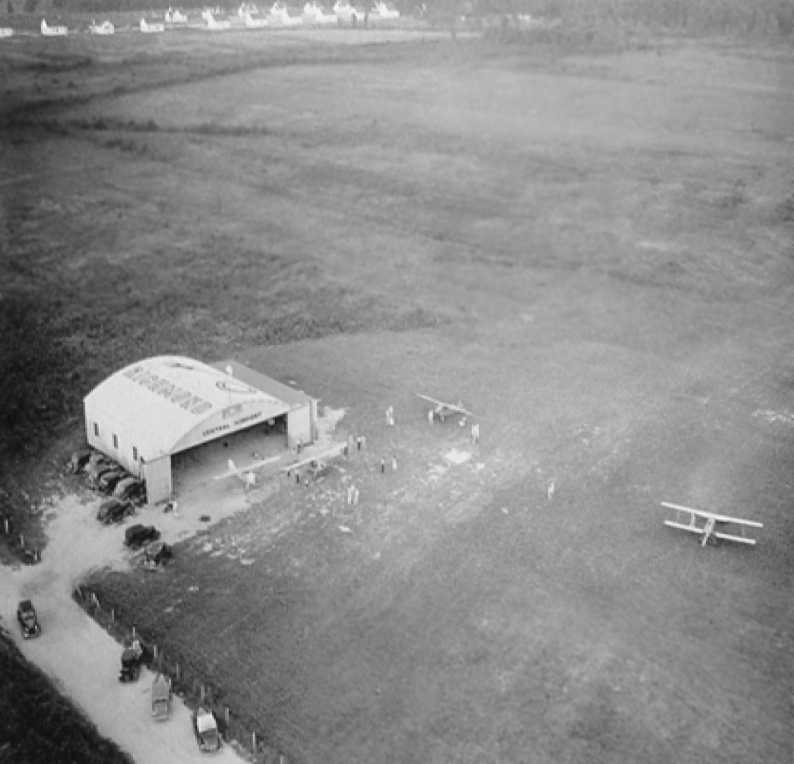
An undated (circa 1930s?) aerial view of Central Airport, showing 3 high-wing monoplanes & a biplane.
This picture of a picture was taken by Kenneth Keeton,
who reported, “I attended the VA ANG last F-16 training mission on 6/20/07, and in the Operations Building there it was!”
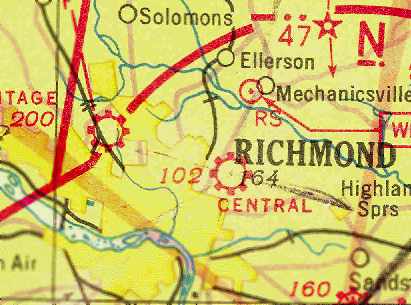
The earliest aeronautical chart depiction which has been located of Central Airport
was on the August 1940 Norfolk Sectional Chart (courtesy of Chris Kennedy).
It depicted Central as a commercial/municipal airport.
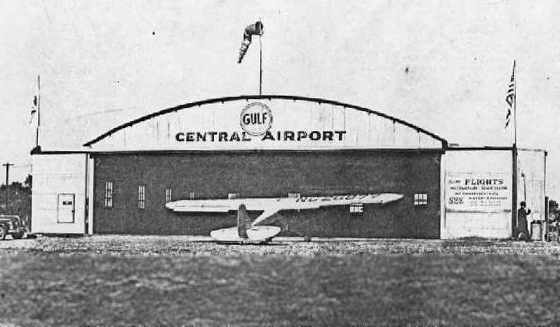
A circa 1940 photo of a Piper Cub in front of a hangar at Central Airport.

A circa 1942-43 aerial view looking north at Central Airport from the 1945 AAF Airfield Directory (courtesy of Scott Murdock)
depicted the field as having 3 runways.
The directory Central as a 168 acre irregularly-shaped property within which were 3 sod & gravel runways, with the longest being the 4,500' WNW/ESE strip.
The field was said to have a total of 15 wood & metal hangars, with the largest being a 60' square structure.
The field was said to be privately owned & operated.
The April 1946 Norfolk Sectional Chart (courtesy of Chris Kennedy)
continued to depict Central as a commercial/municipal airport.
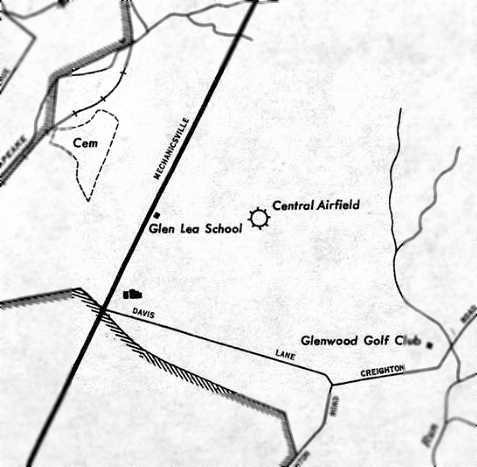
Central Airport, as depicted on a 1946 USGS map.
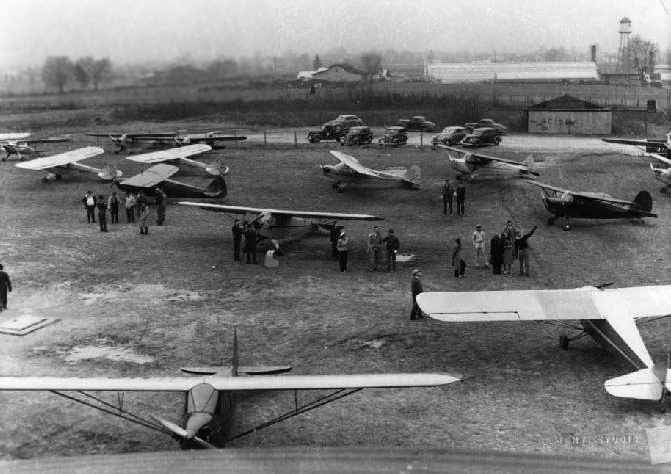
An undated photo of a large number of Piper Cubs at Central Airport.

An undated photo of Floyd Clark, Aubrey Loving, and a police officer in front of an unidentified police monoplane,
with a Central Airport hangar in the background.
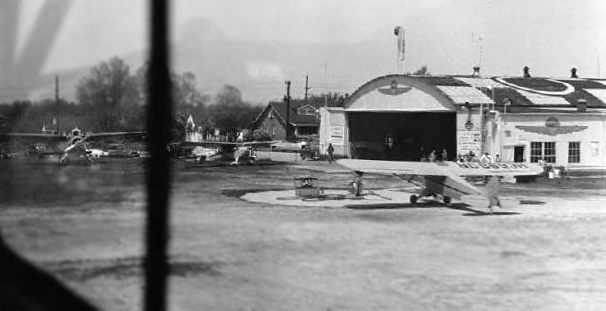
A late-1940s photo of a hangar & several monoplanes at Central Airport.
Claude Beck recalled of Central Airport, “I learned to fly there in 1948.”
A 1952 aerial view showed Central Airport as having 3 grass runways,
with 3 hangars & 6 light aircraft on the west side.
Gordon Gallison recalled, “Central Airport: When I was about 3 years old, my Dad would take me to Central airport to see the airplanes.
Sometimes a Navy blimp was there to refuel & get some food.
I still remember when he asked the blimp commander if he could lift me into the gondola as the wind moved it around the mooring mast.
That was my first blimp 'ride'.”
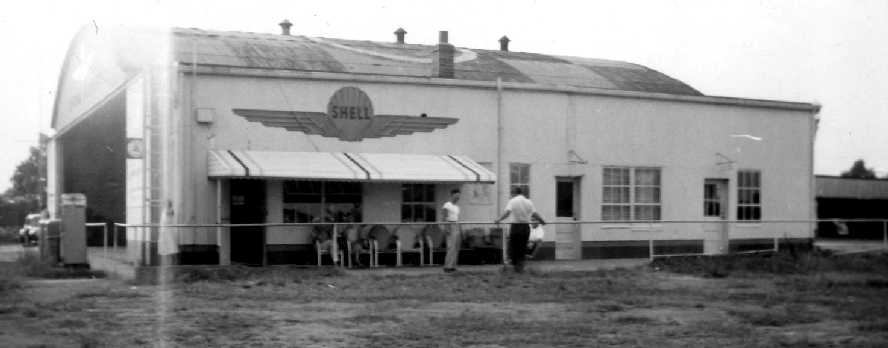
An August 9, 1953 photo by Carlton McGinley (courtesy of Dianne Gardner) of a Central Airport hangar.
According to Diane Gardner, “My father, Carlton 'Mac' McGinley housed his plane, a Ryan PT low-wing trainer, at Central Airport.
He owned & rented many planes from Central & knew many of the men that congregated at the airport.”
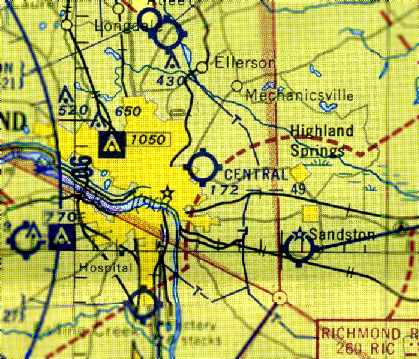
The last aeronautical chart depiction which has been located of Central Airport
was on the July 1954 Norfolk Sectional Chart (courtesy of Chris Kennedy).
It depicted Central as having a 4,900' unpaved runway.
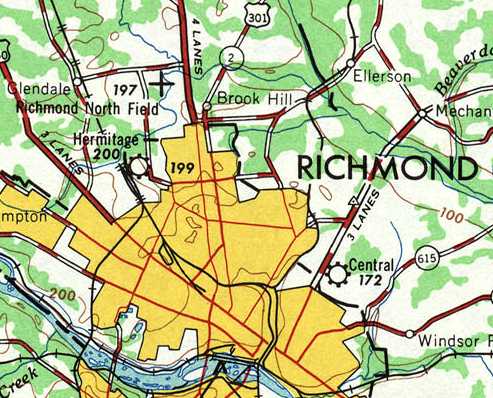
The last aeronautical chart depiction which has been located of Central Airport was on the 1955 USGS topo map.
Central Airport was evidently closed (for reasons unknown) at some point between 1954-56,
as it was no longer depicted at all on the January 1956 Norfolk Sectional Chart (according to Chris Kennedy)
or the 1956 USGS topo map.
A 1968 aerial view no longer showed any trace of Central Airport, with the site having been covered by housing,
and it was no longer depicted on the 1969 USGS topo map.
The name of Central Airport apparently lived on,
as the 1984 USGS topo map labeled the property as “Central Gardens”.
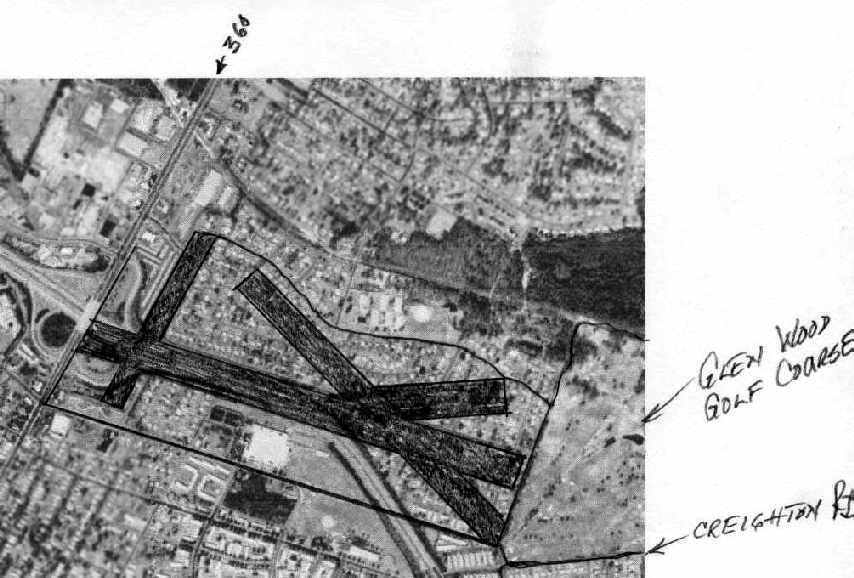
The layout of Central Airport's 4 runways, annotated by Claude Beck over the 1994 USGS aerial photo of the property.
There were no visible traces of the former airport remaining at the site.
The site of Central Airport is located east of the intersection of Interstate 64 & Mechanicsville Turnpike.
____________________________________________________
Thompson Field / Lee Field / Port Richmond Airport, Port Richmond, VA
37.56, -76.85 (East of Richmond, VA)
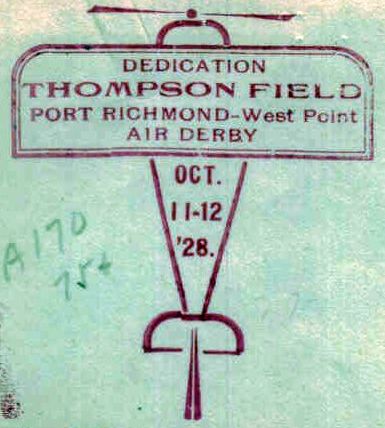
A postmark commemorating the 10/11/28 Dedication of Thompson Field, along with an Air Derby.
This short-lived small airport was located along the banks of the Pamunkey River.
The origins of Thompson Field were described in an article by Frances Hubbard in the 3/16/05 issue of the Tidewater Review.
According to the article, Thompson Field was named after Port Richmond's Mayor, Crosby Thompson.
The 8/3/28 issue of the Tidewater Review reported that work was progressing on the new Thompson Field,
which was said to have 2 graded runways: 3,000' & 2,000' long.
Several visits & inspections were made by military leaders from the Army's nearby Langley Field.
A postmark commemorated the 10/11/28 Dedication of Thompson Field, along with an Air Derby.

A December 10, 1928 photo of Thompson Field (courtesy of Frances Hubbard),
depicting what appeared to be several Army twin-engine biplane bombers along with a smaller single-engine biplane.
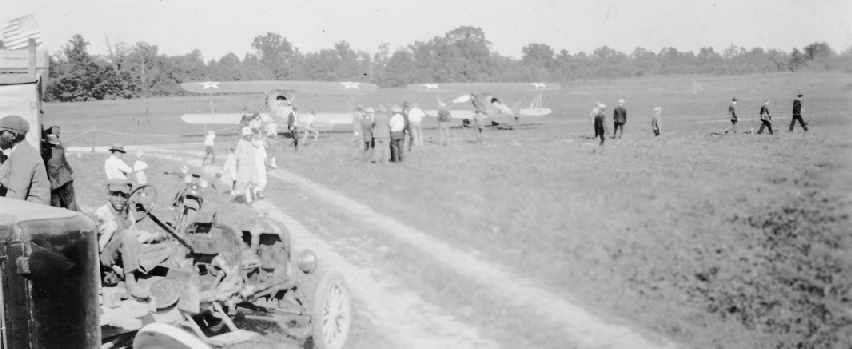
An undated (but presumably 1928) photo of Thompson Field,
showing several Army biplane fighters (courtesy of Frances Hubbard).
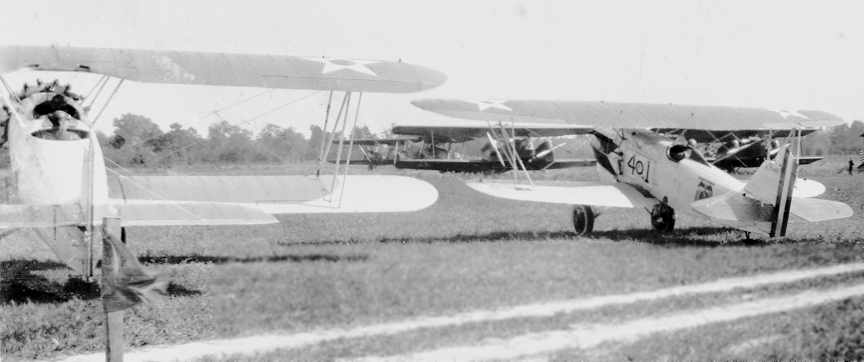
An undated (but presumably 1928) photo of Thompson Field,
showing several Army biplane fighters (courtesy of Frances Hubbard).
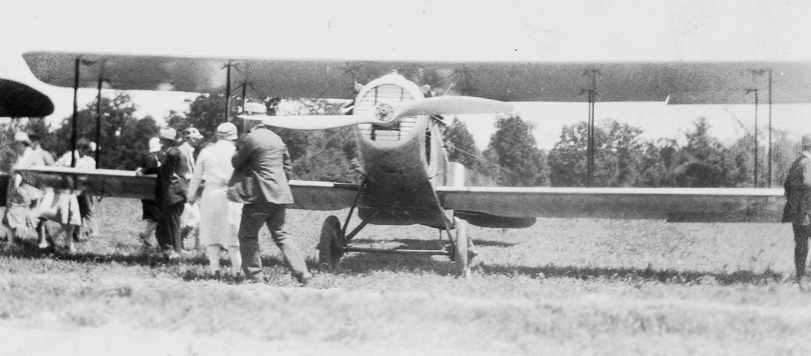
An undated (but presumably 1928) photo of Thompson Field,
of a Army single-engine biplane (courtesy of Frances Hubbard).
Elis Olsson also reported that the field was known by a local name - Lee Field,
a reference to the fact that the property was once owned by the family of Robert E. Lee.
But “the official name for this airport was Thompson Field.”

A 1/10/29 Department of Commerce Airway Bulletin described Thompson Field
as a municipal airport, owned by Crosby Thompson, and operated by the City of Port Richmond.
The field was said to consist of an irregularly-shaped 88-acre sandy clay parcel,
on which were depicted two 3,000' runways, oriented east/west & northwest/southeast.
The field was said to not have any lighting or hangars.
The 8/29/29 issue of the Tidewater Review reported that “Thompson Field... is said by the U.S. Army Air Corps
to be the best field in this part of the country & is in use by military & commercial planes.”
The 12/12/29 issue of the Tidewater Review reported of aerial combat manueavers stages at Thompson Field
using 24 aircraft from the Army's Langley Field & the Marines' Quantico Field.
It said that “aside from Langley Field & Byrd Field,
Thompson Field has more visiting planes than all other fields in VA.
Landings for the last 9 months total 1,058.”
Strangely, Thompson Field was not depicted at all on the 1930 USGS topo map.
The 6/23/32 issue of the Tidewater Review reported that a flying school had been estalished at Thompson Field.
A night airshow was held on 7/18/32 to celebrate the installation of Thompson Field's lighting system,
according to the 7/21/32 issue of the Tidewater Review.
A total of 1,500 enthusiasts were in attendance.
Thompson Field was described by the The Airport Directory Company's 1933 Airport Directory (according to Chris Kennedy)
as consisting of an irregularly-shaped 120 acre sod field,
with two 3,000' runways, oriented northwest/southeast & east/west.
The field was said to offer a hangar, fuel, and limited repairs.
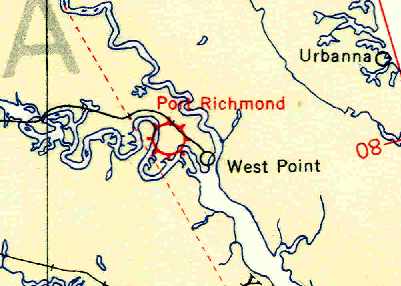
The June 1934 U.S. Navy Aviation Chart (courtesy of Chris Kennedy)
depicted the field as “Port Richmond” Airport.
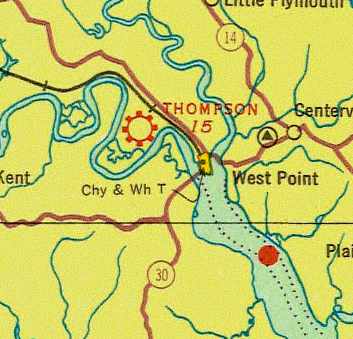
The 1935 Norfolk Sectional Chart depicted “Thompson” Field as a commercial or municipal airport.
The 1/1/36 Department of Commerce Airway Bulletin
described Thompson Field as a municipal field, consisting of an irregularly-shaped sod field.
It was said to have 2 graded 3,000' runways, oriented northwest/southeast & east/west.
The field was said to offer facilities for servicing aircraft, day only.
Thompson Field was evidently abandoned at some point between 1936-37,
as it was no longer listed among active airfields
in The Airport Directory Company's 1937 Airport Directory (according to Chris Kennedy)
nor depicted at at all on the August 1940 Norfolk Sectional Chart (according to Chris Kennedy).
By 1944, a much larger West Point Airport with paved runways had been built by the federal government
5 miles to the southeast in nearby West Point.
A 1963 aerial view showed that the outline of Thompson Field was still recognizable,
but there were no other specific remains of the airfield.
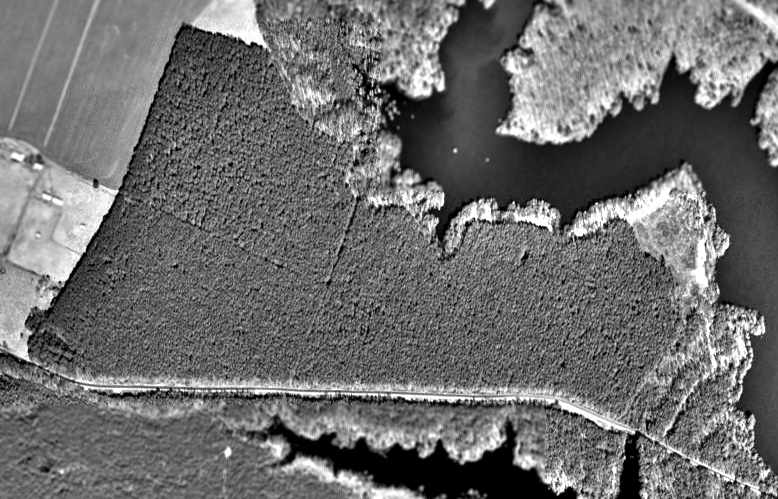
As can be seen in the 1994 USGS aerial photo,
remarkably after 65 years the outline of Thompson Field is still recognizable,
although the area of the airfield is now wooded.
By comparing with the airfield layout as depicted on the 1929 Aiway Bulletin,
the original shape of the airfield is still easily discernable.
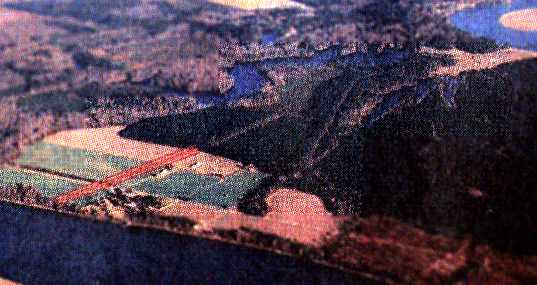
An undated (circa 1990s?) aerial photo by David Robinson looking northeast at the site of historic Thompson Field (dark area in center),
with the new planned runway highlighted in red on the left.
In an interesting development, the property adjacent to this long-dormant airfield may see aviation activity again.
Elis Olsson reported in 2005, “David Robinson & I are working on permitting a grass strip on my parents farm.
My planned sod airstrip will be in the barley field,
which may be 1/2 mile west of the original Thompson Field. It will be 2,000' x 75'.”
The site of Thompson Field is located on the north side of West Euclid Boulevard.
____________________________________________________
37.478, -77.23 (Southeast of Richmond International Airport, VA)
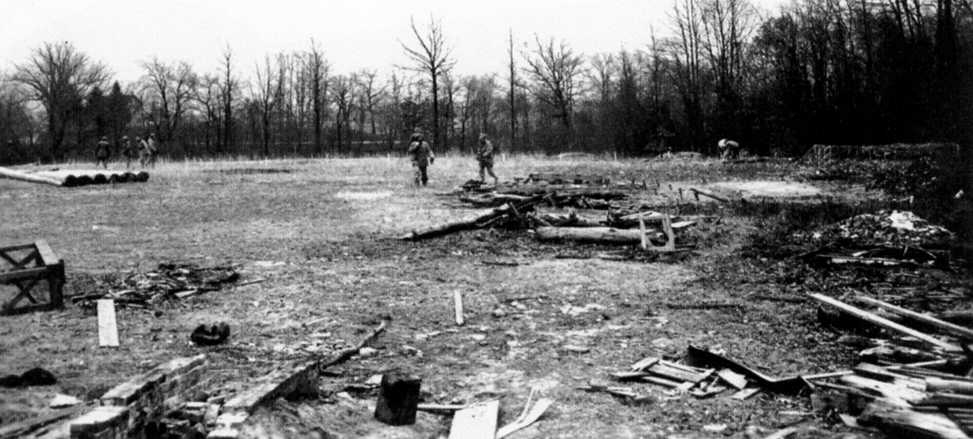
A circa 1942 photo (courtesy of Kenneth Keeton) of the Elko Decoy Airfield under construction by the 936th Camouflage Battalion.
According to a Henrico County history book (courtesy of Kenneth Keeton),
“Early in World War II, the Federal Government seized the land west of White Oak Road & south of Portugee Road, some 2,400 acres.
Landowners were given 30 days to move so construction could start on a decoy airfield.
The purpose of the field was to fool any enemy bomber pilots.
The men of the 936th Camouflage Battalion spent a few months in late 1942 creating dummy landing runways that would look real from 20,000 feet.”
The decoy airfield was constructed 5 miles southeast of Richmond's Byrd Field,
and it was arranged in an identical fashion, with 3 'runways' in the same orientation as Byrd Field.
It was intended to protect Byrd Field by confusing enemy aircraft & drawing them away from their real target.
According to James "Slim" Wilberger, the decoy airfield was equipped with working lights,
as well as decoy airplanes, buildings and trucks constructed of plywood.
As constructed during the war, the decoy reportedly consisted of a network of roads in addition to the runways,
which were carved out of the dense woods to the southeast of Byrd Field.
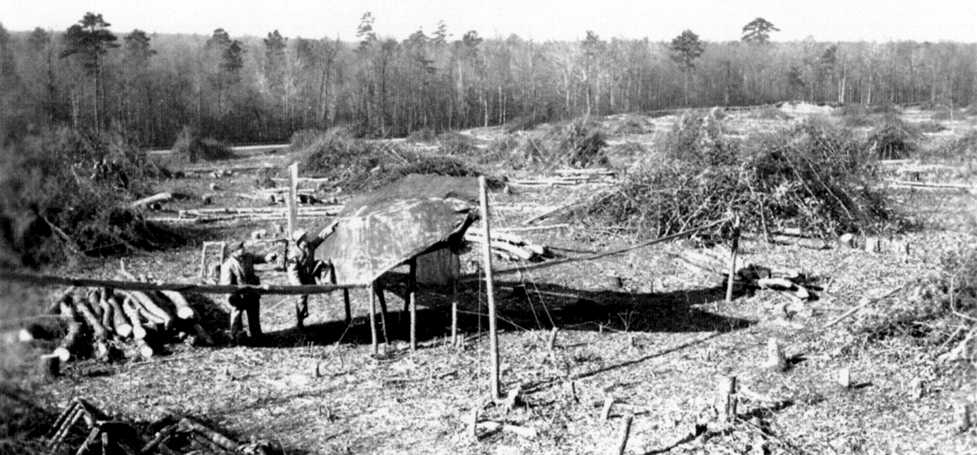
A circa 1942 photo (courtesy of Kenneth Keeton) of a dummy aircraft constructed out of lumber & camouflage netting at the Elko Decoy Airfield.
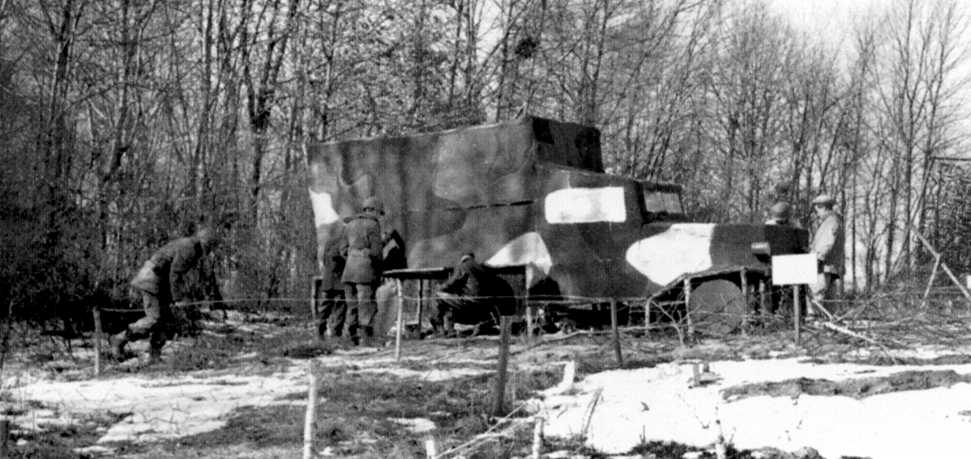
A circa 1942 photo (courtesy of Kenneth Keeton) of a dummy truck at the Elko Decoy Airfield,
positioned at the edge of the treeline so as to give the impression of being one of a number of vehicles parked within the trees.
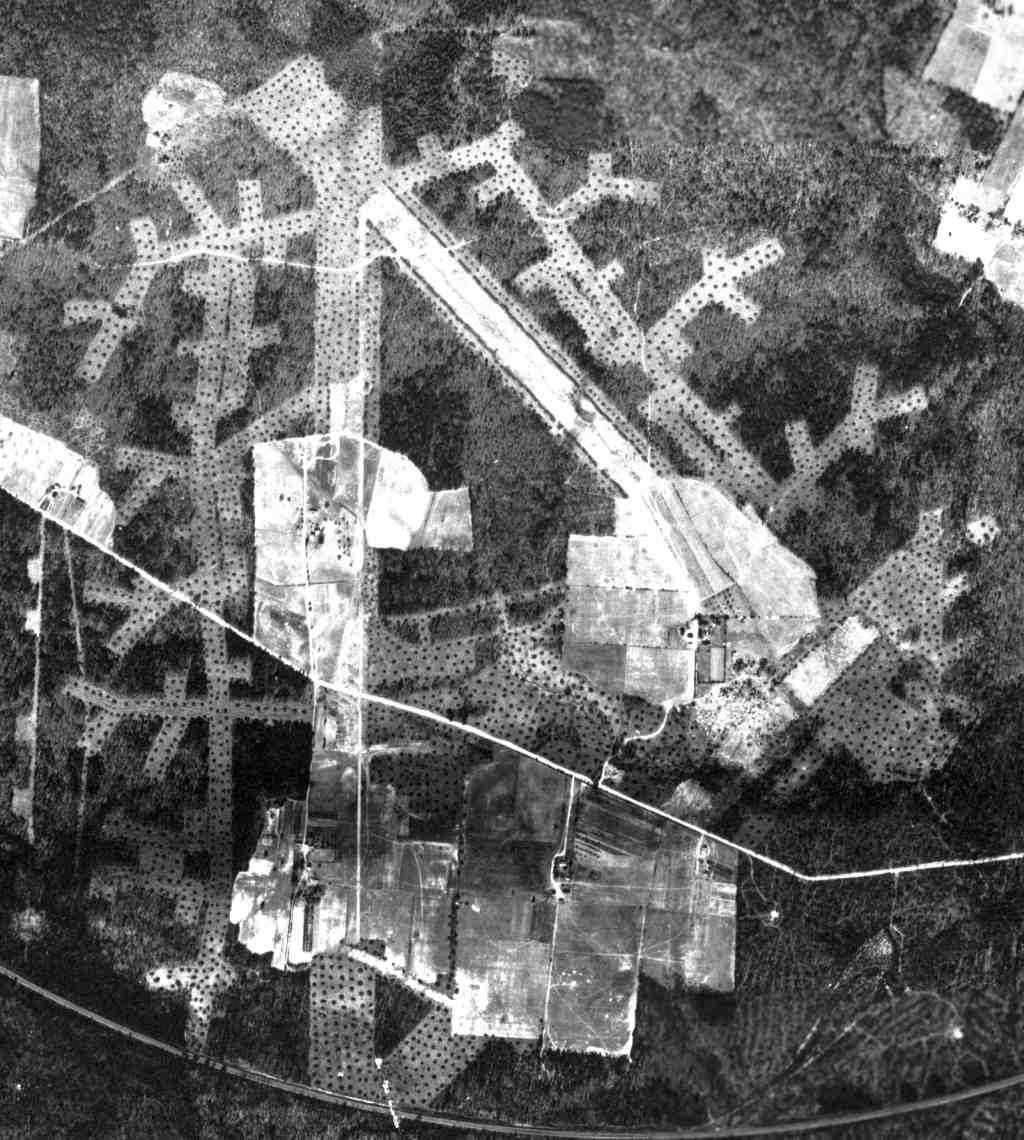
A remarkable 3/9/43 aerial view (from the National Archives, courtesy of Lyle Browning)
showed the Elko Decoy Airfield as having 3 runways (perhaps still in the process of being cleared)
along with an extensive network of taxiways & aircraft dispersal pads.
According to Lyle Browning, “Supposedly a pilot landed on one of the runways with a fairly large plane (I've heard a B-17 or a large civilian aircraft).
It would appear that the nort4hwest/southwest runway was in the best shape for landing so it was probably that one that was landed upon.”
According to a Henrico County history book (courtesy of Kenneth Keeton),
“In September 1943 the 1896th Engineer Aviation Battalion moved from Byrd Field into camouflaged plywood Quonset huts at the decoy field.
They stayed until March 1944.”
It has been reported that the decoy airfield was located beyond the eastern terminus of Portugee Road,
beyond which the road turned to dirt.
At this point an unlocked gate sat at the western edge of the decoy airfield site.
The 1944 USGS topo map did not depict any trace of the Elko Decoy Airfield.
The 1946 Commerce Department Airman's Guide (courtesy of Chris Kennedy)
described the “Elko Auxiliary Field” as being located “5 miles east of Richmond AAB,
is similar in design & layout to the Richmond AAB,
but runways are unsuitable for landing by aircraft of any type.
Care should be taken not to confuse this field with the Richmond AAB.”
The Elko decoy airfield was not depicted at all on the 1946 USGS topo map.
At the end of WW2, the federal government transferred the 2,400-acre Elko tract
to the Commonwealth of Virginia.
It was zoned M-1 & M-3 (Industrial) from the 1950s, but it sat abandoned for years.
According to James "Slim" Wilberger, the Elko tract was used after WW2 for occasional infantry training.
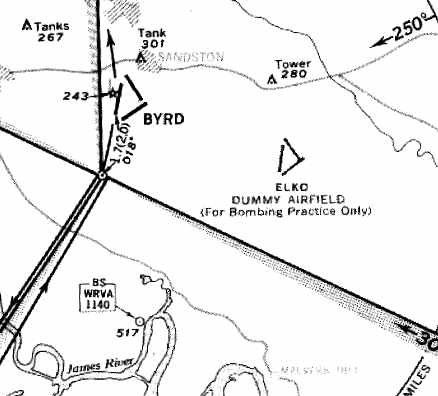
The only official depiction of the decoy airfield which has been located
was on a 1955 approach plate for Byrd Field.
The 3 runways of "Elko Dummy Airfield" were depicted on the approach plate
(which would make sense, as you wouldn't have wanted a pilot to mistake it for the 'real' airport).
The decoy airfield was apparently used as a bombing target by the National Guard fighter unit based at Byrd Field,
as the approach plate included the remark of "For bombing practice only" on the decoy airfield.
The 1957 USGS topo map depicted the outline of a portion of 3 runways of the Elko Decoy Airfield.
The Elko Decoy Airfield was not depicted at all on the 1965 Norfolk Sectional Chart (courtesy of John Voss),
or subsequent Sectionals.
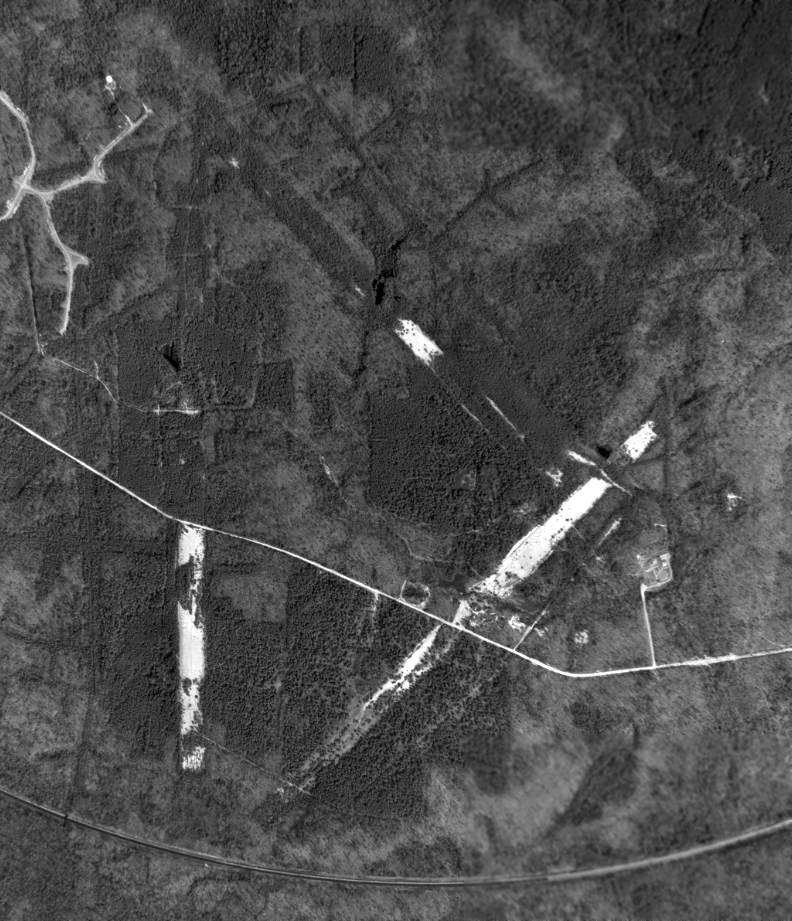
A 3/20/63 USGS aerial view showed the very recognizable outline of 3 runways mimicking the layout of Richmond Byrd Field.
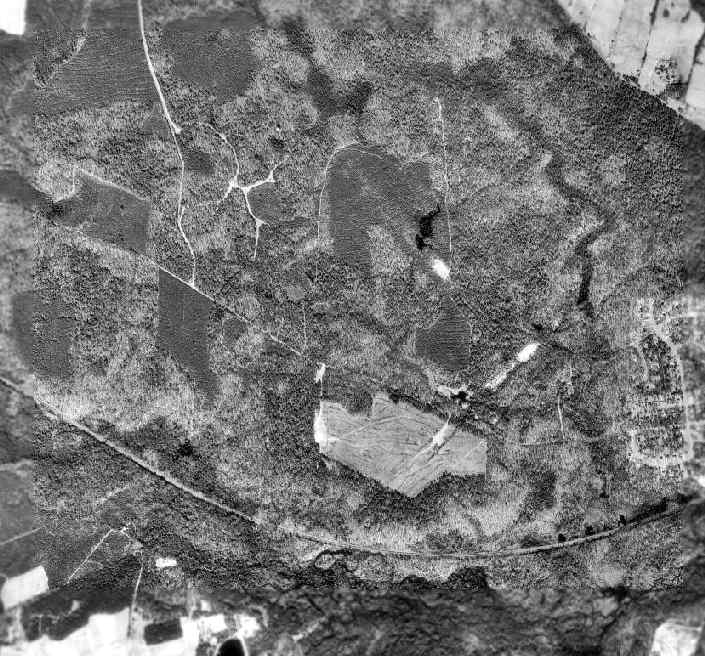
The 1994 USGS aerial photo showed the faintest trace of the triangular outline of the 3 decoy 'runways' in the center of the photograph.
The area was otherwise densely wooded.
When Interstates 64, 95, and 295 were constructed nearby,
the Elko Tract became more desirable for redevelopment.
In 1994, Henrico County officials commissioned a study: The Elko Tract, an Industrial Evaluation Report.
Lyle Browning recalled, “I did some archaeological survey of the Elko Tract in the 1990s.
I grew up in the area & was familiar with the Elko Tract.
When I did my archaeological survey there, Runway 2/20 was still virtually intact.
The runway surface was clay & it simply wouldn't grow anything.
It was wide & long enough as well as dense enough in dry weather to support aircraft.
Extrapolating back to WWII would make it a really convincing effort.”
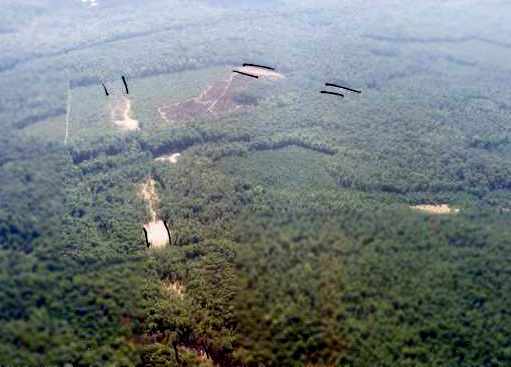
A 1996 aerial view of the site of the Elko Decoy Airfield,
in which the alignment of the former decoy runways has been annotated.
On May 20, 1996, Henrico County, the Commonwealth of Virginia,
and the partnership of Motorola & Siemens Corporation announced their agreement
for development of a semiconductor DRAM manufacturing plant on the site of the Elko Tract,
now renamed the White Oak Technology Park.
Any traces of the former decoy airfield would presumably be removed in the course of the property's redevelopment.
However, James "Slim" Wilberger reported in 2004 that "So far the old airfield has not been affected."
He also reported that "this past fall the Virginia National Guard were holding field exercises in the woods."
The site of the Elko Decoy Airfield is located east of the intersection of Portugee Road & Technology Boulevard.
____________________________________________________
37.06, -77.12 (Southeast of Richmond, VA)

A 1938 aerial view of Waverly Airport.
The Waverly Airport was evidently established at some point between 1935-36,
as it was not yet depicted on the 1935 Norfolk Sectional Chart.
The earliest reference to the field which has been located
was in the 1/1/36 Department of Commerce Airway Bulletin.
It described Waverly Airport as an auxiliary airfield, consisting of a rectangular sod field,
with two 1,800' runways.
The field was said to offer no servicing.
The Airport Directory Company's 1937 Airports Directory (courtesy of Bob Rambo)
described Waverly as a municipal airport having two 1,800' sod runways in an "L" shape,
oriented east/west & north/south.
The earliest depiction of Wavery Airport which has been located was a 1938 aerial photo.
It depicted the field as having 2 unpaved runways, oriented in an “L” shape.
According to the book "Virginia Airports" by Vera Rollo & Norman Crabill (published by the VAHS),
a 5/20/38 article noted that this was the date of the first airmail pickup at Waverly.
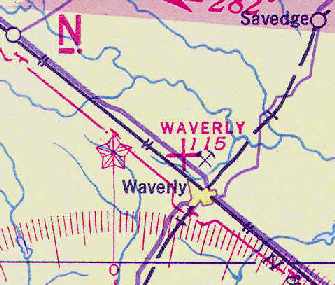
The earliest aeronautical chart depiction of Wavery Airport which has been located
was on the July 1941 Norfolk Sectional Chart (courtesy of Chris Kennedy).
It depicted Waverly as an auxiliary airfield.
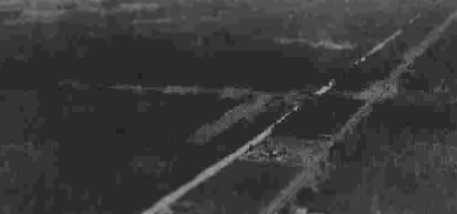
A circa 1942-45 aerial view looking east at Waverly Airport from the 1945 AAF Airfield Directory (courtesy of Scott Murdock)
depicted the field as having 2 grass runways.
The directory described Waverly Airport as a 164 acre rectangular property
within which were 2 sod runways, measuring 1,670' northeast/southwest & 1,500' northwest/southeast.
The field was said to have 4 wooden hangars, each measuring 40' x 24'.
The airport was said to be owned by the City of Waverly, and privately operated.
The April 1944 US Army/Navy Directory of Airfields (courtesy of Ken Mercer)
described Waverly as having a 1,700' unpaved runway.
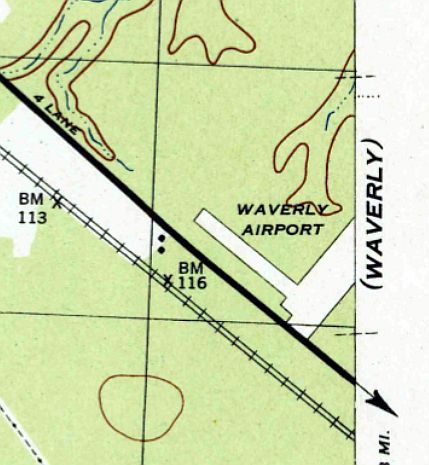
The 1944 USGS topo map depicted Waverly Airport as having 2 perpendicular runways.
The April 1945 Norfolk Sectional Chart (courtesy of Chris Kennedy)
depicted Waverly as a commercial or municipal field.
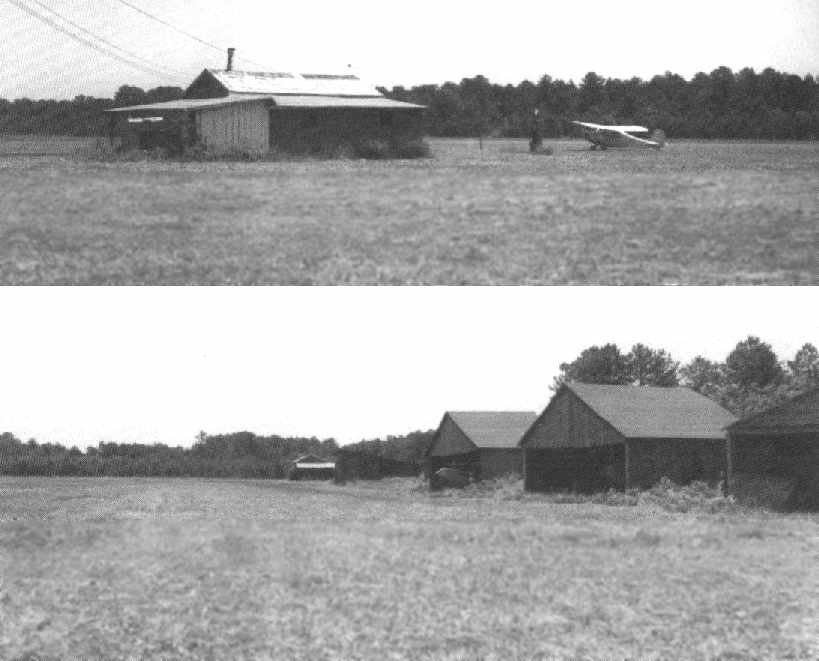
Two 1949 photos of Waverly Airport,
depicted a single taildragger at the field, along with a row of 5 wooden hangars along one of Waverly's grass runways.
The runway at Waverly had been apparently been significantly lengthened at some point between 1944-65,
as the Aerodromes table on the 1965 Norfolk Sectional Chart (courtesy of John Voss)
described Waverly Municipal as having 2 runways, with the longest being a 4,400' turf strip.
The last photo which has been located showing aircraft at Waverly Airport was a 1966 aerial view,
which showed a single light aircraft along with 2 small hangars to the west of the runway intersection.
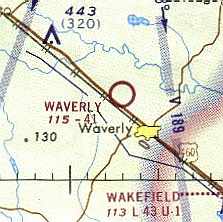
Waverly was still depicted as an active airport on the 1972 Washington Sectional Chart (courtesy of Mike Keefe),
and described as having a 4,100' unpaved runway.
The Waverly Airport was evidently closed (for reasons unknown) at some point between 1972-75,
as it was no longer depicted at all (even as an abandoned airfield)
on the 1975 Washington Sectional Chart (courtesy of Ed Drury).
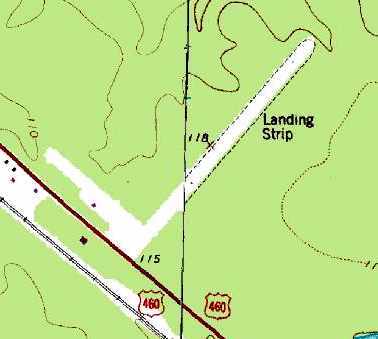
The 2 abandoned runways of the former Waverly Airport were still depicted on the 1989 USGS topo map,
but it was labeled simply as "Landing Strip".

A 1989 USGS aerial view looking northwest showed the 2 grass runways of Waverly Airport still remained remarkably cleared,
but there was not sign of the hangars depicted in the 1949 photos.
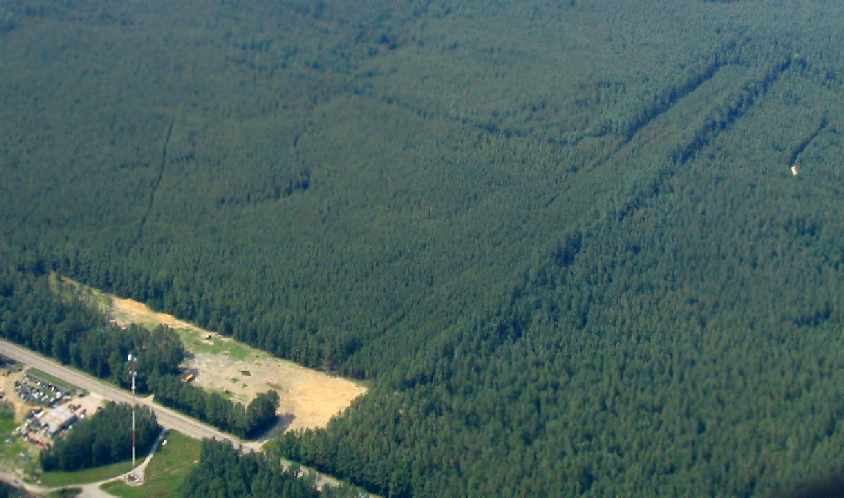
An aerial photo by Paul Freeman, taken 6/04 from a Diamond Eclipse,
looking north at the remains of the 2 runways at Waverly.
The outline of the 2 former runways were still recognizable,
but you wouldn't necessarily recognize it as a former airfield unless you knew where to look.
Thus, this former airfield is rapidly slipping away into obscurity.
The primary reason is, contrast to the 1989 aerial photo,
the main runway (oriented northeast/southwest) had been filled in with trees.
The rectangular outline of the former runway was still recognizable,
as the trees within the former runway area were uniformly shorter than those trees in the surrounding forest.
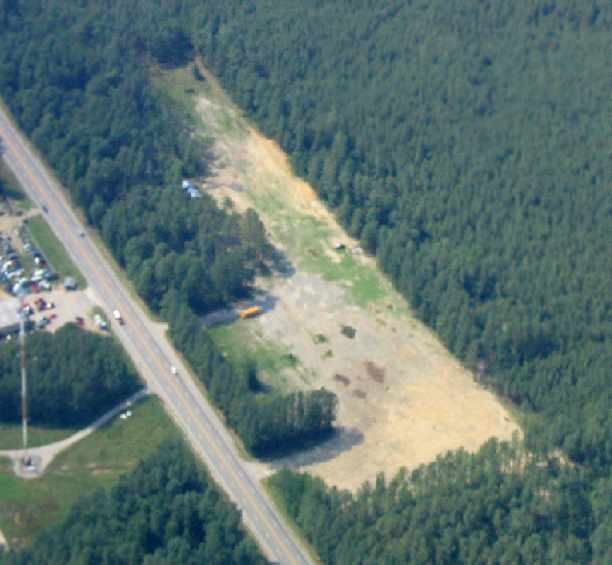
A 6/04 aerial photo by Paul Freeman of the remains of the former crosswind runway at Waverly.
The area of the shorter crosswind runway had remained cleared (for reasons unknown),
with several vehicles stored in the area (including what appeared to be a former school bus).
There was no sign of any former airport buildings.
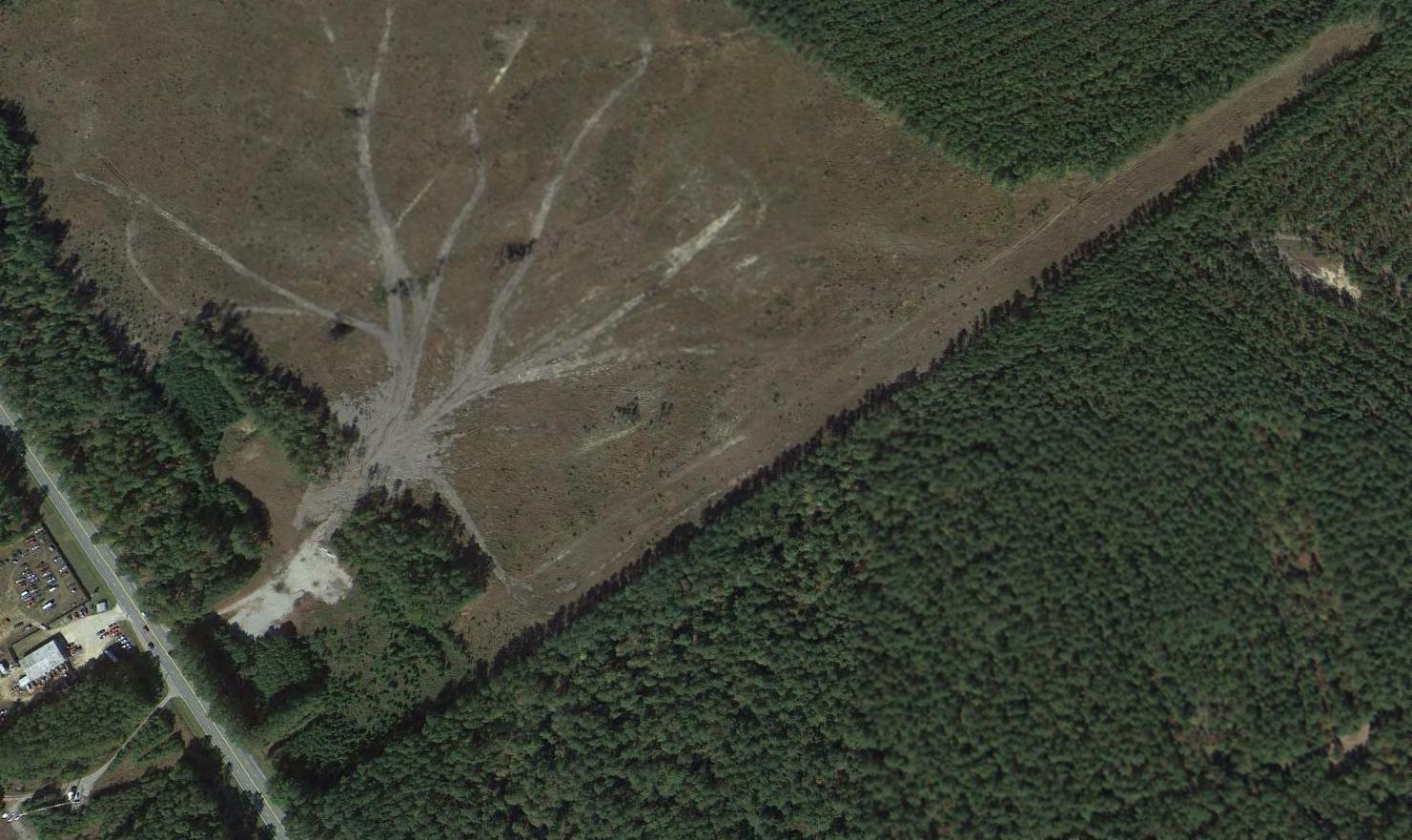
A 2014 aerial view looking northwest at the site of Waverly Airport showed the outlines of the 2 former runways were still recognizable,
but land had been cleared adjacent to the 2 runways for some unknown purpose.
The site of Waverly Airport is located on the northeast side of Route 460, one mile northwest of Waverly, VA.
____________________________________________________
Fort Lee Army Airfield, Petersburg, VA
37.284, -77.345 (South of Richmond, VA)
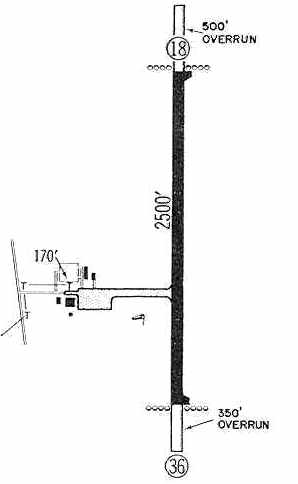
Fort Lee AAF, as depicted in the 1960 Jeppesen Airway Manual (courtesy of Chris Kennedy).
This military airfield was located on the grounds of the Army's Fort Lee.
The Fort Lee AAF was apparently built at some point between 1956-60,
as it was not depicted on the 1955 USGS topo map or the January 1956 Norfolk Sectional Chart (according to Chris Kennedy).
The earliest depiction of Fort Lee AAF which has been located
was in the 1960 Jeppesen Airway Manual (courtesy of Chris Kennedy).
It depicted the field as having a single 2,500' paved Runway 18/36,
with a 500' overrun on the north end & a 350' overrun on the south end.
A taxiway led to a ramp on the west side of the runway with several small buildings (hangars?).
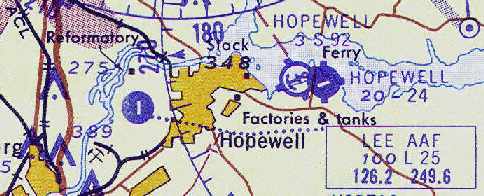
The 1961 Norfolk Sectional Chart (courtesy of Chris Kennedy)
depicted Fort Lee AAF as having a single 2,500' asphalt runway, as well as its own control tower.
Bill Drumright recalled that the Fort Lee Airfield "was built by diverting funds approved by Congress
for barracks, sidewalks, etc. on Fort Lee to the airfield project.
A Fort Lee Commander had requested the airfield be built, but was turned down by the Pentagon/Congress.
In addition to being told no to funding, the FAA had conducted a site review
and found the proposed location had flight restrictions which made it unsuitable,
mainly I believe the problem of one of the approaches being directly over the Federal Penitentiary & water tower."
Drumright continued, "I first heard of the 'Infamous' airfield when I was stationed at Fort Lee in the 1970s.
I was attending a government (read Army) contracting officer course
at the Army Logistics Management Center located on Fort Lee.
The instructors used the incident of the Airfield as a teaching tool
because it showed so many violations of contracting law.
Everything from diverting funding approved by Congress for specific construction
to undue Commander influence being placed on the Contracting Officer involved to falsify contracts & 'make it happen'.
The last time I was there, there still existed a permanent, brick I believe, barracks building in the shape of an 'L'.
The barracks was suppose to be in the shape of a 'U'.
The missing wing in the 'L' shaped one happened because the money for that wing
was used in building the unauthorized airfield."
Drumright continued, "As to why the Commander wanted an airfield,
I can only relate to you what I was told during the contracting officer class.
At the time it was built, Army Aviation was the up & coming thing in the Army,
and more as a status symbol than anything else,
one of the 'requirements' of a Commanding General was to have an airfield.
It also seems to me that the General lost his Legion of Merit award & was forced to retire."
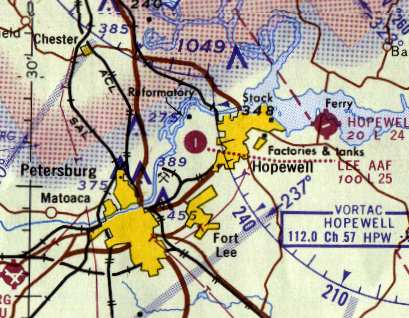
Fort Lee AAF was still depicted on the 1965 Norfolk Sectional Chart (courtesy of John Voss),
but it evidently no longer had an operating control tower.

The earliest photo which has been located of Ft. Lee AAF was a January 1965 photo by Steve Yannone,
showing an Army CH-21 helicopter on the grass in front of several L-19s, Beavers, Caribous, and a hangar.
Steve recalled, “Ft Lee VA... where I was stationed in the Army 1964-66.
I was the crew chief on this CH-21 helicopter, the only helicopter stationed there.
Notice they have me parked as far from the hangar as possible off the ramp on planked steel planking, I wonder why.
There was just one hangar with a small supply building behind it.
The tower was just either walking out of operations building attached to the hangar or looking out the window, no real tower.
We did jump hundreds of riggers & the sport parachute team from Ft Lee, even the Army's Golden Knights while they were there testing some new chutes.
We also flew in several air shows at some small local airfields.
There were several Army fixed-wings: L-19s, Beavers, and one Caribou.
The Air Force had a couple Beavers but not as permanent station; there was a communications center at Lee that they brought people in for a few days at a time.
The prison off the end of the runway... we were to turn out to the East as soon as possible to avoid direct flight over it.”
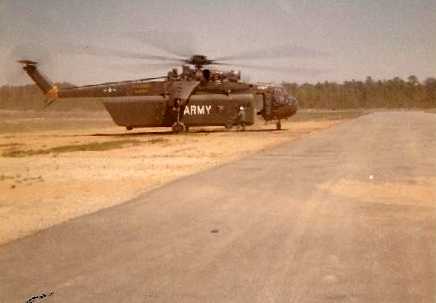
A May 1965 photo by Steve Yannone of an Army Sikorsky CH-54 Tarhe Skycrane with an underslung cargo pod at Fort Lee AAF.
Steve recalled, “I sure wanted to take a ride in this flying crane!”
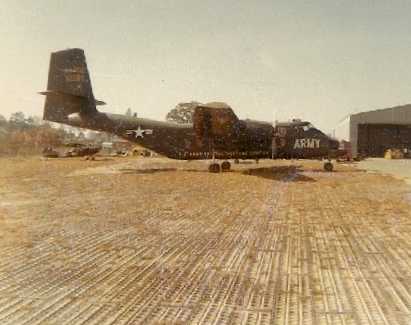
A May 1965 photo by Steve Yannone of an Army Cessna O-1 Bird Dog & a De Havilland CV-2 Caribou on pierced steel planking in front of Fort Lee AAF's hangar.
Steve recalled of the Caribou, “Slow, low and reliable!”
A 1968 aerial view depicted Ft. Lee AAF as consisting of a single asphalt Runway 1/19,
with a paved taxiway leading to a single building on the west side.
Ken Pepper recalled, “When I returned from Vietnam in mid 1968 I was assigned to Lee AAF.
As I recall there was no tower. All communication was done from the office, manned by SSgt Wayne Redmond.
I also don't remember any running water at the airfield.
My MOS was 67B20 crew chief O-1 Birdogs. There were none of these at the airfield.
We did have a Ping Pong table in the hangar & played many a heated game there.
I left the Army in Sept 1969; several years later I went back & there was no buildings left standing, just the floor tiles that spelled Lee AAF.”
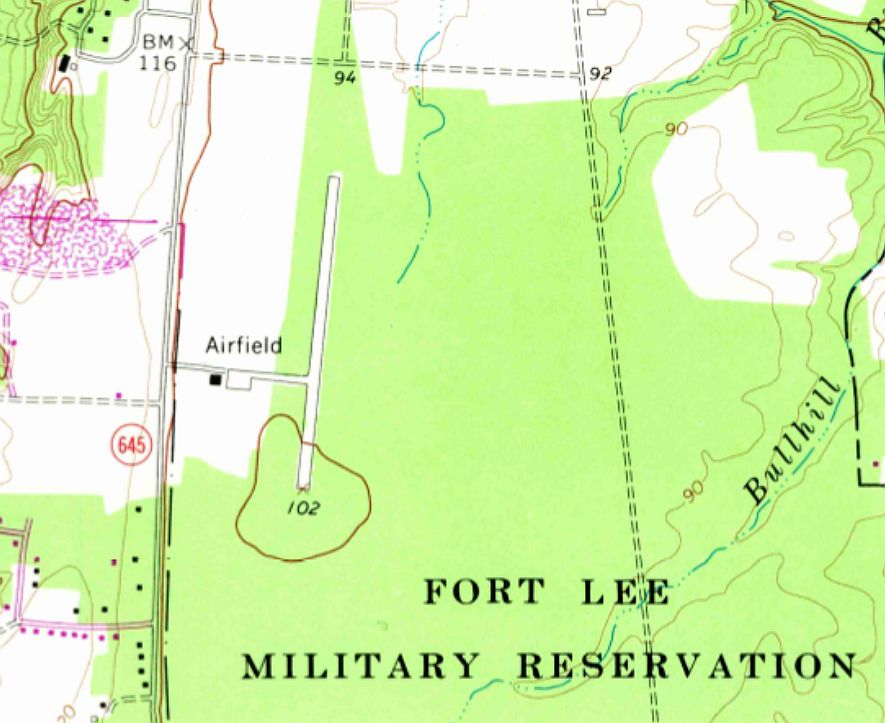
The 1969 USGS topo map depicted the Ft. Lee “Airfield” as having a single paved north/south runway,
with a taxiway, ramp, and a single building on the west side.
Lee AAF was still depicted as an active airfield
on the 1970 Washington Sectional Chart (courtesy of John Clifford).
The Fort Lee Airfield was apparently closed at some point between 1970-72,
as it was not depicted at all (not even as an abandoned airfield)
on the 1972 Washington Sectional Chart (courtesy of Mike Keefe).
Steve Yannone recalled of Ft. Lee AAF, “I went back somewhere around 1975 & the buildings were gone, even the windsock.”
The Ft. Lee runway was still depicted on the 1981 USGS topo map, but it was labeled simply as "Airfield".

As of the 1995 USGS aerial photo, the runway still existed in relatively good condition.
The runway was still depicted on the 1996 USGS topo map, but it was labeled simply as "Airfield".
Bill Drumright recalled in 2003, "The airfield was never really used as an airfield.
Someone blew the whistle on the scandal before it became fully operational.
I know from having lived in that area off and on for the last 20+ years
that it has been used as a Drop Zone by the parachute riggers,
who were trained by the Quartermaster School at Fort Lee,
and a few times I have noticed model airplanes using it.
The last I heard, it is still on government property.
The hangars were removed years ago & I don't think the fuel storage tanks are still in place."

A 2003 aerial photo of the north end of the former runway showed that it remained in very good condition,
although markings appeared to have been added for some kind of vehicle course.
Peter Hantelman reported in 2006, “A sectional chart shows only a parachute drop zone
(for the parachute riggers, which they never use), but no airfield, not even abandoned.
I have driven by the field several times, and it's in great shape!
I've seen active fields that are in poorer condition, and this one absolutely doesn't look like it was last used in the 1960s.
All that's left is a small windsock, one set of bleachers, and a dumpster.”
Virgil Hill reported in 2007, “I am a pilot in the Virginia Army National Guard at Richmond International Airport.
I fly Blackhawks for the 2/224th Aviation Battalion.
The old Ft. Lee strip is used very often by our unit.
We do training there probably 3 times a week, including roll-on landings.
The Army uses the site to teach sling-load rigging to AIT students.
My unit will fly in & let them hook up a water blivet, which we will fly for a moment & set it back down again.
We spend a lot of time there.”
Robert Lee reported in 2013, “I retired from Ft. Lee in 2005 and in fact, it was used as a drop zone for for many years until 2010,
when a parachutist was blown into power lines on the west edge of the drop zone & was killed.
Because of the cost that would be involved in burying or rerouting the power lines, parachute training has been moved to Ft. Pickett, Va.
The airstrip is used frequently by military helicopters for training & on some weekends, as a driver training site.
In the past 16 years, because of the stigma attached to it, no maintenance of any kind has been performed on the paved strip.
It might not have been authorized, but it was well built!
I'm the Secretary/Treasurer of the Mid-Virginia Radio Control Club,
which has had a year-to-year agreement with the Army to use a grass area west of the paved strip for more than 30 years.
You can see our parking area & 500' x 80' [grass] runway directly west of the north end of the paved strip.”
____________________________________________________
Since this site was first put on the web in 1999, its popularity has grown tremendously.
That has caused it to often exceed bandwidth limitations
set by the company which I pay to host it on the web.
If the total quantity of material on this site is to continue to grow,
it will require ever-increasing funding to pay its expenses.
Therefore, I request financial contributions from site visitors,
to help defray the increasing costs of the site
and ensure that it continues to be available & to grow.
What would you pay for a good aviation magazine, or a good aviation book?
Please consider a donation of an equivalent amount, at the least.
This site is not supported by commercial advertising –
it is purely supported by donations.
If you enjoy the site, and would like to make a financial contribution,
you
may use a credit card via
![]() ,
using one of 2 methods:
,
using one of 2 methods:
To make a one-time donation of an amount of your choice:
Or you can sign up for a $10 monthly subscription to help support the site on an ongoing basis:
Or if you prefer to contact me directly concerning a contribution (for a mailing address to send a check),
please contact me at: paulandterryfreeman@gmail.com
If you enjoy this web site, please support it with a financial contribution.
please contact me at: paulandterryfreeman@gmail.com
If you enjoy this web site, please support it with a financial contribution.
____________________________________________________
This site covers airfields in all 50 states.